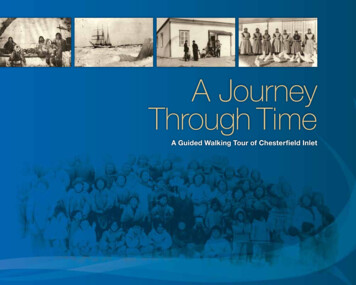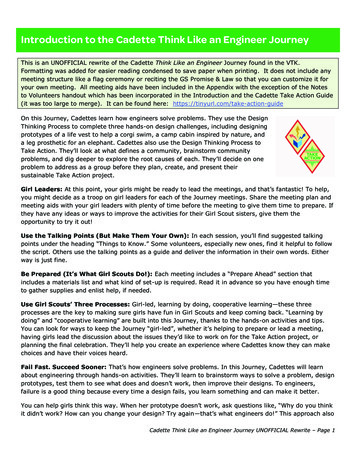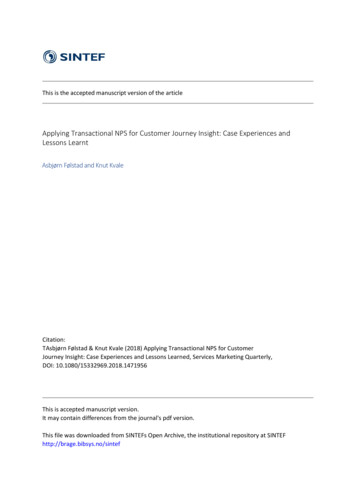
Transcription
A JourneyThrough TimeA Guided Walking Tour of Chesterfield Inlet
SnowFenceAirportRunwayTrailProposed ResidentialSubdivisionRoad toItiviaAirport RoadRoad to First,Second & Third LakeTariuraqR.C.MissionRCMPBarracksHudson’s al LotsNuvuatoTuktPoints of InterestHistorical Reserve(Thule Sites)1 Ship’s Mast18 RCMP Detachment39 Whaling Boats2 Hudson’s Bay Company Complex(now store warehouse)19 Grave Site of RCMP Officer’s Wife20 Water Reservoir40 Hudson’s Bay Company FoxFur Drying Shed Site3 Pig House Site21 Community Cemetery41 Northern Store4 Current R.C. Mission22 Pitsiulak Co-op Warehouse42 Beacon Tower5 Original R.C. Mission23 Health Centre43 Daycare Centre6 Mission Shed and Quonset Hut24 Former RCMP Compound44 Former RC Mission Residence7 Ste. Theresa’s Hospital andMission outbuildings25 Community Complex45 Greenhouse26 Community Dock46 Mission Chicken Shed8 Sir Joseph-Bernier Federal Day School(first school; now hotel) andPitsiulak Co-op Store27 Noel Nuvak Arena47 Mission Shed, Freezer28 Naja Isabelle Home48 Mission Power House29 Conservation Office49 Floating Dock30 Chesterfield Inlet Development Corp.50 Former DOT Weather/Research Station31 Kingnguvaaq Ltd.51 Float Plane Dock Site32 Elders Home Care52 Housing Workshop Site33 Community Freezer53 Chesterfield Inlet Settlement Office Site34 Dog Pound Site (fence)54 Hudson’s Bay Coal Storage Site35 Housing Association55 Inuksuk36 Rec. Hall Site56 Former Continental (Alliance) MissionResidence (In Inuktitut, Ajuqiqtuijirlak)9 Nunavut Arctic College Learning CentreRoad10 Turquetil Hall Site11 First doctor’s HouseHistorical /Archaeological Site12 Waterfront Area13 Iqalukpik Fish Plant14 Victor Sammurtok School15 DOT BuildingsTuktuttaaralaqContinentalAlliance MissionTrail16 Power Plant17 First Radio Station37 DOT Garage Building Site38 RCMP Barracks Site57 Former Health Centre58 HBC Shed Site
A sure sign of previous habitation, a tent ring on the tundra near Chesterfield Inlet - Lee Narraway, August 2002Chesterfield Inlet Then and NowWelcome to the “original” Arctic community,Chesterfield Inlet, which celebrated its100th anniversary in 2011. The storyof the hamlet of Chesterfield Inlet goesback to the early 20th century when theHudson’s Bay Company and the RomanCatholic Church established permanentoperations at this location in 1911.By the time the Bay arrived, the Inuit in thisarea had already met and worked with theqablunaat or Europeans. When the Hudson’sBay Company schooner Pelican unloadedmaterials for its first building at Chesterfield,Inuit came from their camps to see whatthis new group of arrivals were planning.The Inuit have inhabited this area aroundChesterfield Inlet for over 4,000 years.Around 1000 A.D., the Dorset culture,followed by the ancestors of the modernInuit, the Thule people, spread across theArctic and down the Hudson Bay coast.When the climate cooled, interactionbetween widely separated inhabitedareas became difficult and each group ofInuit adapted to inhabited resources. Anumber of regional cultures emerged.A Journey Through TimeIn the area, around Chesterfield Inlet, twoof these Thule sub groups were prominent.One group is known as the Qaernermiut,the northernmost sub-group of the CaribouInuit. The other group was the Aivilingmiut,who relied more on the resources of the sea,the Repulse Bay area. The Qaernermiut livedand hunted in the Baker Lake (Qamani’tuaq)area. They relied largely on caribou andfish. The group closest to present day,Chesterfield Inlet (Igluligarjuk) area, werethe Tariurmiut, who lived along the coast.For hundreds of years they moved up anddown Chesterfield Inlet, travelling inland insearch of caribou, and then returning to thecoast to obtain food from the inlet and thebay. As patterns of travel were established,so were central camping areas. Over thecenturies sod and stone houses were builton these sites, and a type of village startedto emerge, the Thule sites. One of thesesites is located just outside of ChesterfieldInlet, and this site may have had a populationof several hundred inhabitants before anyearly European explorers ever sailed into thearea along the coast and north of the inlet.1
Early VisitorsA number of Thule sites near ChesterfieldInlet were surveyed and excavatedin the 1920s by Peter Freuchen andTherkel Mathiassen, Danish membersof the Fifth Thule Expedition, headed byKnud Rasmussen. In 1968, under thedirection of Charles Merbs, the NorthwestHudson Bay Thule Project (NHBTP) (orthe Sixth Thule Expedition to insiders),began excavating several archaeologicalThule sites at Qamaurvik, Silumiut, andIgluligarjuk sites. Allan P. McCartneyled the team excavating sites betweenChesterfield Inlet and Wager Bay, includingthe large classic Thule Silumiut site.Some Inuit history was preserved forhundreds of years in the form of storiesand legends passed from one generationto the next. Today, residents of ChesterfieldInlet can recollect some of the early eraof the commercial whaling, the arrivalof the Northwest Mounted Police, theearly Hudson’s Bay Company post andits traders, and the first Missionaries,a legacy of more than 100 years.2Likely the first visitor was Sir ThomasButton in the small ship Discovery in 161213, when he explored Hudson Bay. For thenext 150 years, a number of other Britishexplorers visited the Inlet, in search of theelusive Northwest Passage to the Orient.In 1747, Captain William Moor identifiedChesterfield Inlet as a potential routeto China. The Hudson’s Bay Companytook an immediate interest in thisnew possibility and supported furtherexploration by John Bean and WilliamChristopher. Bean failed to find the Inlet,but Christopher explored ChesterfieldInlet, reaching the end of Baker Lakeon his second trip in 1762. He recordedthe absence of a westward passage toChina, but noted sightings of whales inHudson Bay, which led to the start ofcommercial whaling activity in the area.Caribou can often be spotted near Chesterfield Inlet - Lee Narraway, August 2002ABOVE the New York Times announces the sailing of theNeptune, en route to Chesterfield Inlet, August, 1903.Right the first Northwest Mounted Police post in HudsonBay, at Fullerton Harbour in 1904 - JD Moodie, RCMPHistorical Collections, P-164/4.A Journey Through Timeduring winter travel by dog team, and tomake and repair traditional Inuit clothing.Ippaktuq Tasseok, known as “Harry” tothe whaling crews, is mentioned in thelogs of whaling ships for delivering foodand messages to the overwintering crews.He worked mainly for the Americans,appearing in the logs of the Alexander(1886-1887) at Marble Island, and theCanton at Depot Island, (1893-1894)and Cape Fullerton (1895-1896). He wasalso mentioned in the New York Times,December 10, 1905, as the messengerwho brought a letter from Captain RoaldAmundsen to Captain George Comer.Early whaling efforts were unprofitable andit was not until the mid 19th century thatwhalers returned to the area. They visitedregularly until the early 20th century, oftenoverwintering. They hired Inuit to huntcaribou and other game to provide freshmeat to prevent scurvy, to act as guidesA Journey Through Time3
Fullerton in 1897, after a successfulsummer taking six whales.The whalers operated on a seasonal basisfrom their vessels and from shore stationswhere large vats were built for storing therendered whale oil before shipment toEuropean or American ports. The Inuit wereemployed as harpooners and oarsmen insmaller whaleboats and some Inuit werepaid with boats of their own. The whalingcrews stayed on board the mother ship,or rendered the whale blubber on land.Some whalers wintered at Depot Island,where remnants of whalebone and woodand metal artifacts can be seen. There arestone structures too, made by the Inuitor perhaps the Thule - tent rings, foodcaches, fox traps and kayak cradles, inInuktitut, Qajakuvik (singular) or Qajakuviit(plural). Some Scottish and New Englandwhalers used other anchorages amongthe islands and along the coast becausethey felt the Depot Island harbour wastoo shallow. The inner harbour was lessthan five fathoms deep, but it was saidto be ice free earlier in the summer.Exploration of the northern coastlinecontinued. Dr. John Rae wrote to theLondon Times in 1852 that he wasplanning a surveying trip of some 600to 800 miles overland from ChesterfieldInlet to the Back River and by boat upthe west coast of Boothia and returnbetween July 12 and September 12,1853. In the 1890s, the Tyrrell brothers,working for Canada’s geological survey,canoed cross country from the AthabascaRiver starting May 22, to the mouth ofChesterfield Inlet and then as winter drewin, to Fort Churchill by September 3, 1893.From the late 1700s onwards, theHudson’s Bay Company sent schoonersnorth from Fort Churchill each summerto trade with the Inuit. Depot Island wasthe northern limit of these voyages. Northof Depot Island, trade was controlledby European and American whalers.Captain George Comer, originally fromQuebec, and one of the last of theNew England whaling captains, refersto large numbers of muskox, caribou,seal, walrus, and bowhead being takenby Inuit for subsistence and trade withthe whalers. Comer wintered at CapeThe Community StoryBy the early 1900s the whalers werefollowed by traders, and in turn bymissionaries and then doctors, nurses,teachers and government administrators.They provided the services which attractedthe Inuit.The Government of Canada firstappeared in the area in 1903,when the Neptune, carrying RoyalNorthwest Mounted Police, geologistA. P. Low, and others, overwinteredalongside Comer’s ship Era at CapeFullerton. The ship was on a combinedsovereignty and exploration voyage.The same year, George Comer recordedthat Chesterfield Inlet was one of thelocations where Inuit gathered to tradeand seek employment. Guns and sturdywhaleboats were probably the mostsignificant trade items. Then, in theearly 1900s, the value of white fox peltsmade land-based Arctic trading postspossible, year round. This coincided withthe decline of the whaling industry, andby the time the whalers departed, lifealong the northwest coast of HudsonBay had changed considerably.Chesterfield Inlet grew into the major centrenorth of Churchill, Manitoba, serving as atrans-shipment point for supplies for otherHudson’s Bay Company posts. As thelargest Roman Catholic mission in the area,Chesterfield Inlet was known as a medicaland education centre.Above interior of a double igloo, Fullerton Harbour - RCMPHistorical Collections, P-164/41.LEFT the steamer Arctic overwintering in the ice at FullertonHarbour - G Moodie, RCMP Historical Collections P-164/19The opening of a nickel mine in RankinInlet in the mid-1950s almost spelled theend of Chesterfield Inlet. The Hudson’sBay Company post closed from July 31,1961 to March 9, 1964. Many people leftfor employment at the new mine, but whenthe mine closed, some families returned toChesterfield Inlet. Br R. Bedard operatedthe trading post while the Bay was closed.In 1976, the Department of Fisheries andOceans (then Fisheries and Marine Service)Canada established a research centre atSaqvaqjuaq Inlet about 40 km northeastA Journey Through Timeof Chesterfield Inlet in response to theneed for more detailed knowledge of arcticfreshwater ecosystems. The researchcentre was in operation for over eight years.The mouth of the Saqvaqjuaq River waswell used in the past. Remains of a saputit(stone weir) used as recently as the 1960s,can be seen at the head of the first rapids.On the northeast side of the river mouth,there are numerous caches, tent rings,and kayak stands and on the southwestside there are several semi-undergroundwinter dwellings dug into a sandy hillside.Tent rings are found everywhere in theSaqvaqjuaq area. However, Inuit have notlived there permanently for several decades.Today it is visited only for a few days at atime by hunters and families fishing.Today, Rankin Inlet is the mainadministrative centre in the Kivalliqregion. Chesterfield Inlet continues as asmall but well serviced community withwage employment available with themunicipal and territorial government, Inuitorganizations, Northern Store, PitsiulakCo-operative Ltd., Naja Isabelle Home andlocal businesses.5
About Your Walking TourThe complete walking tour of ChesterfieldInlet takes approximately two hours. Itdoes not include the Thule sites outsidethe community. If you are interested invisiting one of these sites, please contactone of the local guides or outfitters,or the local economic developmentofficer. These archaeological sites areprotected, and visitors are encouragednot to disturb anything they find.The original Bay building in the eastern Arctic at ChesterfieldInlet - Anglican Church of Canada, Fleming Collection,P7516-308Women in beaded amautisposed for Mrs. GeraldineMoodie, Major JD Moodie’swife, in 1904. Niviatsinaqaka Shoofly Comer, is seated,centre.- RCMP HistoricalCollections, P-164/216A Journey Through TimeYour Chesterfield walking tour starts atthe Northern Store (formerly the Hudson’sBay Company post) and covers the eastand west sections of the community. Thelocation of many of the original buildingsand current services are included onyour map. Some of the historic sites alsohave signage. Permission is required toenter many of the original buildings listedin this tour, since they continue to beoccupied. Public buildings such as theNorthern Store, the Community Complex,and the modern mission church can bevisited if they are open at the time of yourtour. If you prefer a more detailed tour,please contact the Community EconomicDevelopment Officer at the Hamlet officeA Journey Through Timefor information on guides or tour operators.Copies of the walking tour guidebookcan be picked up at the hamlet office.Visitors may photograph the sites and thebuildings along the tour, but if you wish toinclude local residents in the photograph,you should request their permission first.The people of Chesterfield Inlet are a warmand friendly group and will be happy toassist you on your tour. Most speak Englishas well as Inuktitut, although some of theolder people may speak only in Inuktitut.Although most of the tour is along gravelroads within the community, there areparts that involve crossing over shortstretches of rock and tundra. Thesesections are not difficult, but suitablefootwear is recommended; ATV rentalsmay be available for touring certain sites.Once again, welcome to ChesterfieldInlet, and enjoy your Journey ThroughTime, here in one of the Arctic’soldest settled communities.7
Starting Your TourBegin your tour at the Northern Store(41) at the east end of the community.Beside it (2) is the original Hudson’s BayCompany post. Parts of this building dateback to 1911. The architecture is typicalof all early Hudson’s Bay Company posts,with its white clapboard exterior, red trimand location near the waterfront. CaptainG. Edmund Mack, one of the crew on themaiden voyage of the Nascopie whicharrived at Chesterfield in 1912, describedhow supplies were landed: “The post hada particularly bad beach. Humping cargoon your back, in water up to the waist,was cold work till you got used to it.”Above Chesterfield Post, 1920s - Archives of Manitoba,HBCA 1987/363-C-28/4RIGHT Inuit wintered in igloos until the 1950s. Igloos atFullerton Harbour, 1904 - JD Moodie, RCMP HistoricalCollections P-164/458station for American and Scottish whalingships, and a trading point with the Inuit.Although most Inuit had lived a nomadiclifestyle, they had developed an activetrading relationship with the whalers.One valued trade item was beads, usedto fashion ornate designs on parkas.Community elders who were born at CapeFullerton in those days recalled wearingornate parkas, and learning to play theconcertina, introduced by the whalers.Mounted Police at Cape Fullerton. Hewent out on patrol with the policemancalled Keekiaksik, (she didn’t know hisEnglish name), to Repulse Bay and toother remote camps. In the spring of1914, Leonie’s father, Johnny Tamanguluk,set out by dog team to get the mailfrom Churchill, 700 kilometres south ofHudson Bay. Leonie and Mary Nuvakrecall living at Cape Fullerton with theirparents, during the whaling era.Inlet in 1914, when whaling declined. ManyInuit families followed. Fullerton Post wasused part-time for many years as a stopon patrols to Inuit camps along the coastand inland. Some Inuit who have travelledthrough Fullerton harbour for shelter haveseen old memos or documents left behindby the officers. Many documents, whichmight have contained some history, werenot preserved, and sadly some paperswere used to start fires for warmth.Leonie Sammurtok recalls her fatherworking with the early Royal NorthwestThe Royal Northwest Mounted Police postat Cape Fullerton moved to ChesterfieldIn 1916, W.O. Douglas sailed into theArctic and served there for 17 years, firstBy 1926, the Hudson’s Bay Companypost had extended its depot. Most of thislarge building was used as a warehousefor supplies for other posts in the region.It was also the storage area for thousandsof fur pelts acquired in trade with theInuit. A number of Natsilikmiut familiesfrom the north had travelled south tothe Hudson Bay coast by dog team toseek trade or wage employment withthe Hudson’s Bay Company fur pelttrade or with the whalers in the area.Many of the Inuit who later moved toChesterfield Inlet traded for at least partof the year at Cape Fullerton, in Inuktitut,Qatiktalik. This was the site of the firstdetachment of the Royal NorthwestMounted Police. It was established in 1903as a customs office to oversee the activitiesof the American whalers, to establishCanadian sovereignty, to administerwhaling licenses, collect customs, andcontrol liquor and to maintain order. TheFullerton harbour was a popular winteringA Journey Through Timewith the RNWMP and then the Hudson’sBay Company. In the summer of 1919, hecame to Chesterfield Inlet from Fullertonto meet the Hudson’s Bay Companysupply ship Nascopie. He had the LadyBorden, a tug capable of towing a bargewith supplies. The Hudson’s Bay Companywas still doing some freighting fromChesterfield Inlet to Baker Lake, usingone of the old, half-decked-over coastboats. Also in 1919, the Finback, thelast of the New England whaling ships,struck a reef at Fullerton and sank.A Journey Through Time9
Insp. Beyts and Cst. Pasley leaving Chesterfield Inlet forChurchill, January 1915 - RCMP photo 4109In the early days, Bay managers lived onthe second level of the original Bay complex(2) that is now used for a warehouse,before the post residence was built.Above Misiraq, Elizabeth Unurniq Tapatai and Mary Nuvakwho lived this story. Baker Lake, 1926 – L. T. Burwash,Library and Archives Canada/PA-099412By 1927, nearly 100 Inuit had chosenChesterfield Inlet as their home base,moving to camps to hunt and trap, butreturning to Chesterfield to trade, to meetwith friends or family members, and toobserve religious occasions. The Inuitcontinued to live in traditional dwellings,igloos in winter and skin tents in summer.A photo (left) shows the entire populationof the community in 1927, when clothingand materials of the Euro-Americanculture were becoming more common.well as southern Canadians assigned tothis posting. A number of Inuit who hadworked as “special” constables, interpretersor guides with the Northwest MountedPolice in the early 1900s, later worked forthe RCMP barracks in Chesterfield. Theirnames were not listed in memos or sealedin records, their names were simply lost.By 1929, Inuit ran the supply ship thatdelivered trade goods to the smaller postsin Repulse Bay and Baker Lake. The Inuithad learned their seafaring skills from thewhalers and continue to have excellentboat handling and navigation skills.Residents of Chesterfield Inlet, 1927 - Diocese of Churchill-Hudson BayAbove amphibious biplane on the beach by the Hudson’sBay post at Chesterfield, late 1920s - NWT Archives/LorenzLearmonth N-1987-033:0498RIGHT Inuit crew of the Fort Chesterfield, 1926 - NWTArchives/Lorenz Learmonth N-1987-033:0199From the 1900s through the 1930s, theRCMP barracks in Chesterfield Inlet wasthe largest in the Eastern Arctic, and theforce patrolling the area included Inuit asA Journey Through Time11
The Early DaysBy the 1930s, Chesterfield Inlet wasa major centre in the Canadian Arctic.Attracted to the services, particularlymedical services offered in ChesterfieldInlet, more Inuit spent longer periods oftime in the developing settlement. Dr. L.D.Livingstone was the first resident doctor inthe settlement, and by the mid 1930s thesettlement boasted a three-storey hospital,which then and for many years after, wasthe largest building in the Canadian Arctic.Head east from the Northwest Companystore up the hill to the Petroleum ProductLimited fuel storage area (40). There’s aspectacular overview of the community andthe waterfront. North of the community,just south of the beacon tower (42) andnorth of the airport runway are the Thulesites, in Inuktitut Qarmarviniit, whichyou can visit or see on a guided tour.Above sketch map of the southern end of Chesterfield inlet1932 - Frank T. Davies, University of SaskatchewanRIGHT whaleboats, offered to the Inuit as wages by thewhaling captains - CEDO, June 2005Above Dr. Livingston, dressed for winter in a caribou parka- NWT Archives/Leslie Livingston N-1987-019:0187RIGHT the Mission brought in hens each summer - CourtesyBrian Lewis12In Chesterfield Inlet in the 1930s, theRoman Catholic mission also providedmuch of its own food, and right up to thelate 1960s, brought in several hundred henseach summer and pioneered a successfulpoultry operation long before anyone elsehad tried such a venture in the north. Thiswas discontinued when aircraft beganregular service to the settlement and themission was no longer totally dependanton one ship per year to bring in supplies.Before the arrival of the Hudson’s BayCompany and the Roman Catholic Mission,this area was sometimes used as arendezvous spot for whalers, who cameto the area looking for Inuit to assist them.A few of the old whaling boats, traded tothe Inuit in lieu of wages at the end of theseason, can still be seen nearby (39). Onthe beach below you can see canoes andmore modern aluminum or fiberglass boats.Small storage sheds along the beach houseequipment needed for fishing and hunting.Inuktitut, Iglui, near the mission (7) and thetrading post (2). The RCMP was located atthe opposite end of the community (38). Inthose days winter patrols were conductedby dog team, and the RCMP kept manydogs (34). Since these dogs were notpets, and could be dangerous, they werekept away from the existing settlement.At the top of the hill, just off the road,there is a large white pole embeddedin a concrete base (1). This is themast of one of the early Hudson’s BayCompany sailing schooners retiredfrom service on Hudson Bay.Look out over the community, and notehow it stretches around to the far westernpart of the bay. In the early days, theHudson’s Bay Company and the Missionwere located at one end of the community,and Inuit set up their tents or igloos, inA Journey Through TimeA Journey Through Time13
If the weather is favorable, you may liketo take a walk along the road to the siteof the community wharf (26). In spring,residents snowmobile or ATV to inlandlakes for Arctic char or lake trout fishing.In summer, fishing trips can be arrangedwith a guide or by ATV rental to inlandlakes - first ( Puirsuk), second (Akulliq )and third lake (Amaruqtalik), 10 to 25 kmnorthwest from the community on a gravelroad, or along the seashore for Arcticchar. You might spot residents or visitorschar fishing near the community dock.In the summer, as well, you may be ableto see “sea lift”, the annual resupply ofthe community by ship or barge. Shipsand barges from the ports of Churchilland Montreal arrive between early July orAugust and early September, deliveringconstruction materials, fuel, householdfurnishings, vehicles and non-perishablefoods. Barges unload their goods at thewaterfront near the Northern Store. Goodsare then transported by vehicle and loaderto sites around the community. “Sealift” is an exciting time, when everyoneis eagerly awaiting the year’s supplies.Above The public dock at Chesterfield Inlet Lee Narraway, August 2002LEFT Hopital Ste Therese at Chesterfield, 1947. At the timeInuit lived in tents in summer, igloos in winter - Library andArchives Canada/PA-210318A Journey Through Time15
Residents await the arrival of the Nascopie, 1946 - George Hunter, Library and Archives Canada/e004665353The Early Communityincreased it to its present size. In 2008to 2009, the managers’ staff house wasrenovated, and the old Bay complexwas re-roofed and a new heating systemwas installed. (The original Hudson’sBay Company posts, across the Arctic,were sold in 1988 by the Hudson’s BayCompany to a group of employees, whonow operate the Northern Stores.)Hudson’s Bay post, 1928 - NWT Archives/LorenzLearmonth N-1987-033:0469Now return to the Northern Store(41), and start your tour through theearly days of Chesterfield Inlet.The Hudson’s Bay Company built itsfirst permanent post in the Arctic inChesterfield Inlet in 1911 (2). The buildingthat currently houses the manager ofthe Northern Store was part of the firstbuilding to be constructed during thetime of the Hudson’s Bay Company post.An addition to this building in the 1920sA Journey Through TimeWhen the store is open, check it out. Thecash registers, charge card machines, anda wide range of merchandise have replacedthe basic bolts of cloth, bags of flour, teaand sugar, and other trade goods stockedby this store until the early 1960s. If themanager is available, you may request abrief tour of the warehouse section of thebuilding (2), now used to store suppliesand some furs, but initially intended forfurs, and at one time seal oil. On thesecond floor, with its open beams, youcan see where the original 1911 structureand the 1920s structure were joined. Thesloped ceiling boards of the upstairs boastsignatures of the famous (and not sofamous) that have passed through or livedin Chesterfield Inlet over the past century.17
The Roman Catholic MissionOne floor beam portion is open on thesecond level. This supported a woodenhoist to lift dry goods and materials with arope from the main floor of the warehouse.The original wooden platform hoist is nowon display at the Hudson’s Bay Company inManitoba. For many years, before the arrivalof the annual sealift, a number of squaredances and often teen dances were heldat the old Hudson’s Bay Store warehouse.The Pig House - Marion LaVigne, Outcrop. 1990The meat rack and doghouse behind the RCMP barracks,Chesterfield Inlet - G. Moodie, Glenbow Archives NA-2306-15.18The plaque near the entrance to thebuilding shows two young Hudson’s BayCompany apprentices, R.J. Spence andJ.L. Ford, with a loft full of pelts, in 1928.The other photograph shows the HBCcomplex as it looked in that same year.The Canadian Press reported in 1933 onthe “annual Christmas ball” at Chesterfield.“It took place in the decorated storeroom ofthe post of the Hudson’s Bay Company. Anaccordion, violin, mandolin and improviseddrums furnished the music.” Inuit, attiredin elaborate costumes, “danced with thewhites”. The menu, according to the report,included deer shank and caribou tenderloin.A Journey Through TimeIn addition to the main building, thereare a number of smaller buildings usedfor storage and staff housing. Off to thenortheast of the main Hudson’s BayCompany complex was a small buildingin traditional HBC white and red, knownonly as the “pig” house (3). For manyyears, part of the annual resupply to thetraders in remote posts included severallive pigs. These pigs were housed in smallbuildings during the fall. When the weatherturned very cold, they were slaughteredto provide fresh pork to the HBC staff.Head west, from the Hudson’s BayCompany post area along the main road.The first large complex you will come tois the current Roman Catholic missionand church . The mission was built in1954 and for over 30 years served asthe recreational and social focus for thecommunity, as well as its religious centre.The new church was completed 10 yearslater in 1964. If the church is open, dropin to see the stained glass windows whichincorporate scenes of traditional Inuit life.Further along the road is the originalRoman Catholic mission . The story ofthe mission is told in a special plaqueerected by the diocese to mark the 75thanniversary of the founding of the mission.Members of the RCMP, the Bay and theMission were also expected to supplytheir own meat. For example, freshlyharvested caribou and other wild meatwould be hung to cure on the meatrack next to the RCMP barracks.Above Construction of the Roman Catholic Mission Church,Chesterfield Inlet, 1912 - Diocese of Churchill-Hudson BayCHB 04 0005right the Roman Catholic Mission at Chesterfield Inlet - LeeNarraway, August 2002A biography of Bishop Turquetil mentionsthat as an Oblate priest, a year afterhis arrival in the Manitoba missions, heheaded north during the winter of 1901,on snowshoes, to preach the Gospel tothe Inuit, but a frozen knee obliged him toturn back. During the summer of 1906, hemade another attempt. The young Normanmissionary arrived at the Sarvartuk, theKazan River, where he remained sevenA Journey Through Timemonths with the Inuit, studied theirlanguage, observed their manners andcustoms, and shared their meals of rawfish or caribou boiled over a fire of moss.In July 24, 1912, Arsène Turquetil boardedthe M.S. Nascopie at the port of Montreal.On September 3, the vessel droppedanchor at Chesterfield Inlet. With theauthorization and encouragement ofBishop Ovide Charlebois, Bishop ofKeewatin, Father Turquetil founded thefirst Catholic mission on the west coast ofHudson Bay. He named it ‘Mission NotreDame de la Délivrande’, after a sanctuarydevoted
Mission Shed and Quonset Hut Ste. Theresa's Hospital and Mission outbuildings Sir Joseph-Bernier Federal Day School (first school; now hotel) and Pitsiulak Co-op Store . followed by the ancestors of the modern Inuit, the Thule people, spread across the Arctic and down the Hudson Bay coast.










